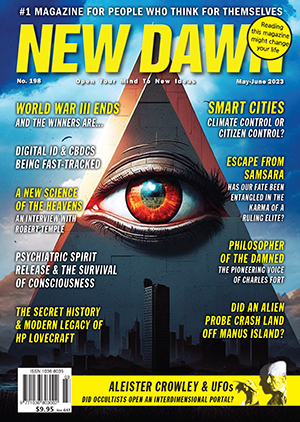From New Dawn 198 (May-June 2023)
When, at fifty-nine I finally returned, after twenty years, to clinical psychiatry, I had no idea that I was on the verge of an inconceivably strange adventure. Treating patients by talking to troublesome earthbound spirits could not have been further from my thoughts. And yet, three years later, I was doing just that. My decision to write a book on survival after physical death came out of my work with earthbound spirits and their connection to the dying process.
To clarify the situation, I’ll give a brief explanation of what, to my knowledge, happens at death, when the soul passes for further development to the Light, the entrance to the spirit world.
It fits what souls report to therapists during spirit release. Mediums may receive similar information. This transition is not invariable. If the soul has no concept of survival or if death is traumatic and unexpected, the Light may not be visible, and attachment may occur to someone at the scene.
Sometimes attachment occurs by design. Addiction to alcohol, drugs, some otherworldly activity, or an intense relationship with another person can result in a soul remaining earthbound by intention. This may become a parasitic connection that is difficult to break.
A soul may also be stranded in some familiar location and produce effects, such as haunting, or it may attach to another living individual, either knowingly or unknowingly. Such a spirit may move on of its own accord, but there may be a need for release.
The practice of spirit release – or exorcism, as it is called when part of a religious practice – goes back thousands of years and continues to be used by religions worldwide. In Brazil, Spiritism, founded by Allan Kardec, born Hyppolite Rivail, has many hospitals and thousands of treatment centres, where spirit release by mediums is a main feature of the treatment. There are many other regions, especially in India and Africa, where it is an important part of the social fabric for practitioners of spirit release using local techniques to remove harmful spirits induced as curses (spirit interference).
My personal knowledge and experience concerns spirit attachment in the industrialised Western world, where the condition, although prevalent, is rarely acknowledged. Except for its use by mediums who need spirit guides for their work, attachment is usually an unwished-for condition in which spirits interfere with the healthy functioning of individuals. I have been concerned mostly with the earthbound souls of those who have died. Some nonhuman spirits (entities) or demonic spirits can also cause problems.
How does one make a diagnosis of spirit attachment in such cases? Since most patients are ignorant of the condition, the most important step is for them to become aware that such a condition may be present.
Any of the following symptoms may manifest: low energy level, character shifts or mood swings, impulsive behaviour, memory gaps, poor concentration, sudden onset of anxiety or depression, abuse of alcohol or drugs, hearing a negative inner voice.
It is very rare for attached spirits to take full control, but such cases have been described. Nearly always, the intrusion shows only moderate effects, as in my patient, Pete who you will shortly be meeting.
The concept of spirit interference raises many questions, such as how do spirits gain entry, and how can we protect ourselves against these secret intruders? While there is no doubt that some people are far more open to spirit interference than others, those who lead healthy lives, without extremes of abuse or indulgence, are the least likely to be troubled.
Attached spirits should be encouraged to go to the Light. Even if not harmful, they may be doorways for harmful spirits to enter. Dealing with them requires special skill.
To assist the transition, I ask for the help of a deceased relative of the patient or, if none is apparent, a spirit guide. Such help is often perceived by the patient and leads to effective release. Remote spirit release may be used by therapists with psychic abilities. They scan clients for attached spirits and clear them with or without the aid of spirit guides.
Talking to inner voices is not part of regular psychiatric practice, and I need scarcely say that it did not feature in my formal training. It was only after my meeting with Lance Trendall, the hypnotist whom I mention in the introduction to Psychiatry and the Spirit World, and subsequent training in hypnosis and spirit release, that this door opened for me.
I used it first with my nonpsychotic patients at Fairfield Hospital, especially those who had treatment-resistant depressive and anxiety states. Most of them were keen to use hypnosis and glad of an opportunity to change from the usual medication.
Without mentioning the possibility of attached spirits, I would have them, while in hypnosis, look into an imaginary mirror or imagine being filled with light and look for shadowy areas. I would then ask, “If that area could make a noise (or speak) what might it say?” A response would usually lead to a verbal exchange, with the possibility of exploring the history of an attached spirit. However, in the absence of a verbal response, it was often possible to communicate by finger signals.
I would ask the spirit if it could relate its own experience of physical death, and why it had joined the patient. Attached spirits usually have their own problems that need to be resolved. Sometimes a spirit has a past-life connection to the patient that needs to be explored before a release can occur.
Physical Symptoms Resulting from Spirit Attachment
Innumerable hospital investigations had failed to reveal the cause of Pete’s trouble. He worked as a senior manager and professional trainer and had a very successful career. Pete came to me as a last resort after being offered a marvellous job opportunity abroad. It was a chance that, at fifty, he couldn’t afford to lose.
Before he came, e-mails from both husband and wife had delivered a daunting catalogue of complaints: abdominal pain, joint pains, retching and diarrhea, wide fluctuations in temperature, and periods of severe prostration. Life had become a misery. Had it not been for a wonderfully sustaining and rich marital relationship, he might not have survived.
There were two important clues to the cause of the problem. One had come to light a year before when, during hypnotic regression, Pete had experienced a life in Tibet. As a boy, while being schooled to be a lama, he had been bayoneted to death by a Chinese soldier.
The other clue was his conviction of being possessed. How this came about he could not say. He had first felt it after the death of his mother years before. In Pete’s words, “This thing lives in my descending colon. This is its lair. I can show you the exact place. It can be small or large. When it’s really at rest it’s about the size of a big marble. When it’s fully active it penetrates and permeates my entire body, including my brain. At its worst I feel that it’s killing me by draining all my energy and by consuming my cells and preventing my mind from functioning. It is almost never absent.”
I had Pete relax through visualisation and imagine his body filled with light. He described “a dark, triangular kind of shape” on the left side of the abdomen. What follows in the next account is the verbatim dialogue between me, Pete, and the entity speaking through Pete:
Alan: If it could make a noise, what noise would it make?
Pete: Constant, intense; a raging scream.
Alan: And if that scream could find words, what words would come?
Pete: Hatred.
[A nonhuman entity then identifies itself as Askinra; in appearance, it’s “like a dark flame.”]
Askinra (speaking through Pete): I shouldn’t be in here. I feel trapped like this.
[Askinra becomes aware of voices and light.]
Angels: Come back! Come out!
[Askinra feels blocked.]
Askinra: I can only come through him.
Alan: Tell me, Askinra, what effect are you having on Pete?
Askinra: I’m destroying him. If I destroy him then I can be free.
Alan: Become aware of the angels that are calling your name and tell me what you see.
Askinra: It is as if a pathway goes up through the heart, to the top of the head.
Alan: And where does it lead beyond the head?
Askinra: Into another place that’s very different from this one. It is outside this reality. It’s the place I’m trying to go, but I can’t get there, I can’t get through. Every time I try to get out, I can’t get through.
Alan: At what point are you stopped, Askinra? Try and get through and tell me what your experience is.
Askinra: It’s like a closed door… like something that’s locked.
Alan: Describe the closed door.
Askinra: It’s round and white, like bone.
Alan: Askinra, speak to the closed door that’s round and white, like bone. Ask the closed door, “May I come through?” How does it respond?
Askinra: No.
Alan: Ask the closed door, “What must I do, so that you will open for me?”
Askinra: Die!
Alan: Askinra, are you telling me that you are able to die? You are an immortal spirit, Askinra, how can you die?
Askinra: That’s what the door is for; it’s for the time of death.
[This path of inquiry seemed to be blocked. I decide on another approach.]
Alan: Askinra, tell me, how old was Pete when you joined him?
Askinra: Twelve.
[Askinra entered at the time of the fatal bayonet wound, during the Chinese invasion of Tibet when Pete was twelve in that incarnation, preparing to become a lama. It seems that Askinra was there and was taken by surprise.]
Askinra: Hatred pushes me in there and fixes me in there.
[Pete gives permission for me to speak to the soldier.]
Alan: I’m speaking to the soldier who is putting the bayonet into this boy of twelve, who feels so much hatred. You, the soldier, what do you have to say? You can speak to me. You’re feeling anger, aren’t you? What do you say to the little boy?
Soldier: You have to be destroyed!
Alan: And you hate this boy.
Soldier: I hate everything he stands for.
[The soldier, who on questioning reveals that his name is Chen Ling, now regrets his action. With angelic help, Chen Ling removes his anger from the bayonet thrust. As an indication of his regret, Chen Ling gives the boy a tiny pearl. Askinra is now able to pass through the door in the head, which opens onto a place of mountains and light. Spirit guides are requested. The hand of the guide feels “like a cool stream.”]
Askinra: Sorry, I never meant to be there. Come and find me in the new place.
Afterward, Pete experienced some parting spasms in the left abdomen, but felt much lighter. Healing spirits were called in to cleanse and heal the whole subtle energy system, leaving Pete feeling good.
A month later, Pete described the experience: “The physical symptoms have gone. It was just as distinct as if you were carrying something and it weighed a certain amount and it had a certain texture and a certain feeling to it and that thing was removed from you. With that thing out of the way, I’m free to think and feel and to be aware in ways that I wasn’t before. It has made a huge difference.”
At a ten-year follow-up Pete wrote the following:
The immediate result of Alan’s work with me was that I was instantly relieved of a wide range of intensely debilitating physical symptoms upon which all other approaches, both “allopathic” and “alternative” had been ineffective. My mental and emotional stance also changed for the better. I had more clarity and felt more contented and happy with my present circumstances and substantially more positive about the future. It is not the case that everything in my life was perfect after this event, or that I never suffered again from either physical illness or emotional upset, but it is for me a fact that this was one of the major turning points in my life and that, in many ways, I never looked back. My experience was, essentially, that of being freed from “something” that had trapped me in a limited and painful version of my Self. Since then, my life and work have been successful in a number of ways that I did not, previously, anticipate.
The case of Askinra is a white crow,* waiting to be acknowledged. And it was a beautiful crow, wasn’t it? I loved the gift of the small pearl and the hand of the guide feeling “like a cool stream,” and Askinra’s invitation to Pete to come and find him in the new place. “Caw!”
* Professor William James was convinced that an unseen world existed and gave much thought to how it could best be demonstrated. Here is his much-quoted statement: “If you wish to upset the law that all crows are black, it is enough if you prove one single crow to be white.”
My take on what the professor meant is this: white crows are rare, and so are, to sceptical scientists, anomalous events. We only need to prove the existence of a single white crow (or anomalous event) to disprove the black crow “law.”
The above is reprinted with permission of the publisher from chapter 3 of Dr. Alan Sanderson’s new book Psychiatry and the Spirit World: True Stories on the Survival of Consciousness after Death (Foreword by Edith Fiore, PhD), © 2023 Park St Press, an imprint of Inner Traditions International. www.InnerTraditions.com. The book is available from all good bookstores. A review of the book can be read on page 65.
© New Dawn Magazine and the respective author.
For our reproduction notice, click here.




